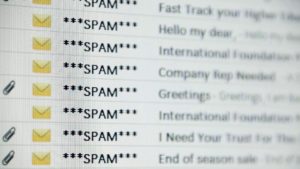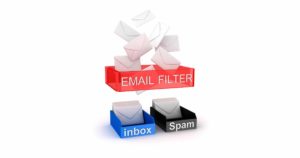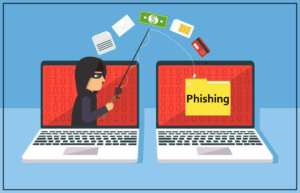Cyber Security Three-Part Series: Knowledge is protection
Part 1: Be wary of your inbox – from spam to phishing scams
Spam isn’t just a questionable meat replacement, it’s also a huge issue for businesses. Besides clogging up your inbox, spam can also reduce your productivity. A Kapersky report claims that people can lose up to 80 hours of productivity a year – that’s two weeks! – in dealing with spam messages. Other reports suggest two days, but the more email you receive, the more time you lose. For example, I received 44 spams messages yesterday alone, and I have 1316 messages in my spam folder for just the last 30 days. 
Keeping your inbox clean and keeping it safe are synonymous. It’s also a time saver, and every physician can use more time on their hands. The number has varied over the years but nearly half of all emails have been spam leading up to the pandemic. Those numbers are expected to be higher in 2020 and 2021 with so many people working from home and email scams on the rise looking to take advantage.
The majority of spam is adult-related, advertising, and scams and fraud. You don’t necessarily need to target the scams and fraud, but they’re more easily purged if you make the following efforts to protect your inbox with simple processes and practices.
Trash the junk: if it’s in your junk/spam folder and you don’ recognize the sender, delete it before opening and make sure your settings don’t allow for automatic images to download on your computer(s). It’s as important for your staff as it is for you as a physician, both on office and personal computers, and your phone or tablet.
Filter the fodder: Nearly every email service has a built-in spam filter. Use yours and check to see what landed in there in case it grabbed something it shouldn’t have. If it did, it’s easy to have it remember the sending address as safe. Sometimes spam still gets through so make sure you flag it when it does to prevent it from sneaking by again. Anti-spam and/or antivirus software is also a great addition.
Address the address: Bots are behind the insane number of spam emails sent daily around the globe. They use intelligent algorithms to guess your email. By picking a unique or complex address, you can keep them guessing rather than hitting yours. Don’t post your email publicly, and if you need an address to use in forums or other groups, consider a free, disposable email address service.
Silent treatment: While you should feel free to unsubscribe from legitimate email lists you know are safe – a common practice to help keep that inbox clean – you should NEVER reply to a spammer. They don’t know if the email address they hit up is a valid one until you reply. Verifying that it is real opens up opportunity for them.
As you can imagine, some of the scams have only increased in effectiveness during the pandemic. There are some very realistic emails from what looks like a legitimate source. For example, Netflix could be asking you to sign in to fix an issue with our account. This attempt at phishing is called account verification. If you come across it and want to verify that your real Netflix account is fine, just go to the address yourself in your browser and log in. NEVER click the link.
Another popular phishing attempt is Cloud File Sharing, which contains a link to what looks like a shared file on Google Docs or Dropbox or some other file-sharing space. Again, avoid all risks and stay away from the links and typing your email or other information into an imposter site. Misuse of DocuSign is a popular attempt to try to verify an email, and to steal personal information and even your signature.
Spam emails that appear to come from the government all have the same tactics in mind. And fake invoices target individuals and businesses, as do delivery notifications from FedEx, UPS or online retailers. The strategy from your end is always to go straight to the source (the domain name) whenever there is any doubt in your mind.
And time is so precious for all of us. Safe sources of online services, including quality medical transcription services, can also save you valued time.
Home, secure home
Whether or not you handle any of your business at home, you’ll want to ensure cyber safety is still top of mind. This starts with the way you hook up – your wifi connection – to how you browse. The fewer connected devices, the fewer entry points there are for cyber criminals. Make sure you’re not working from default credentials on your wifi network – change your configuration in your router for your wifi and router passwords.
Be smart about your online visits. Your browser should tell you if you’re going somewhere that may be unsafe, so don’t ignore the warnings if they come. Double-check the address if you’re accessing information through a link. Or, better yet, key it in manually. Be diligent about your downloading. Files can have hidden malware and there are millions of misleading predator websites out there. Stay informed on the latest threats and keep up on your antivirus options to make sure your inbox is as healthy at home as at the office.
Next up: Protecting your personal data
See our newest article on Cybersecurity for the Holidays at Beware of Cybercriminals This Holiday Season (2ascribe.com)
2Ascribe Inc. is a medical transcription services agency located in Toronto, Ontario Canada, providing medical transcription services to physicians, clinics, and other healthcare providers across Canada. Our medical transcriptionists take pride in the quality of your transcribed documents. WEBshuttle is our client interface portal for document management. 2Ascribe continues to implement and develop technology to assist and improve the transcription process for physicians and other healthcare providers, and recently introduced AUTOfax. AUTOfax works within WEBshuttle to automatically send faxes to referring physicians when a document is signed off by the healthcare professional. As a service to our clients and the healthcare industry, 2Ascribe offers articles of interest to physicians and other healthcare professionals, medical transcriptionists, and office staff, as well as of general interest. Additional articles may be found at http://www.2ascribe.com.


